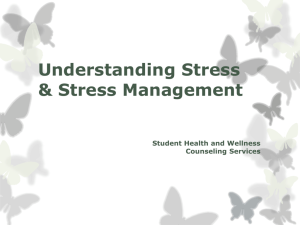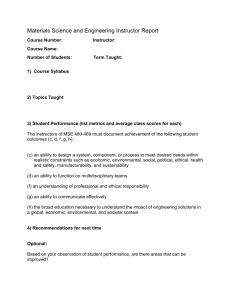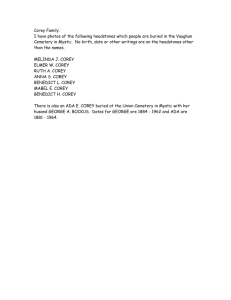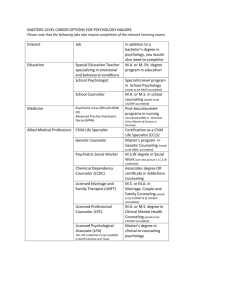Goals for Abnormal Psychology Class:
advertisement
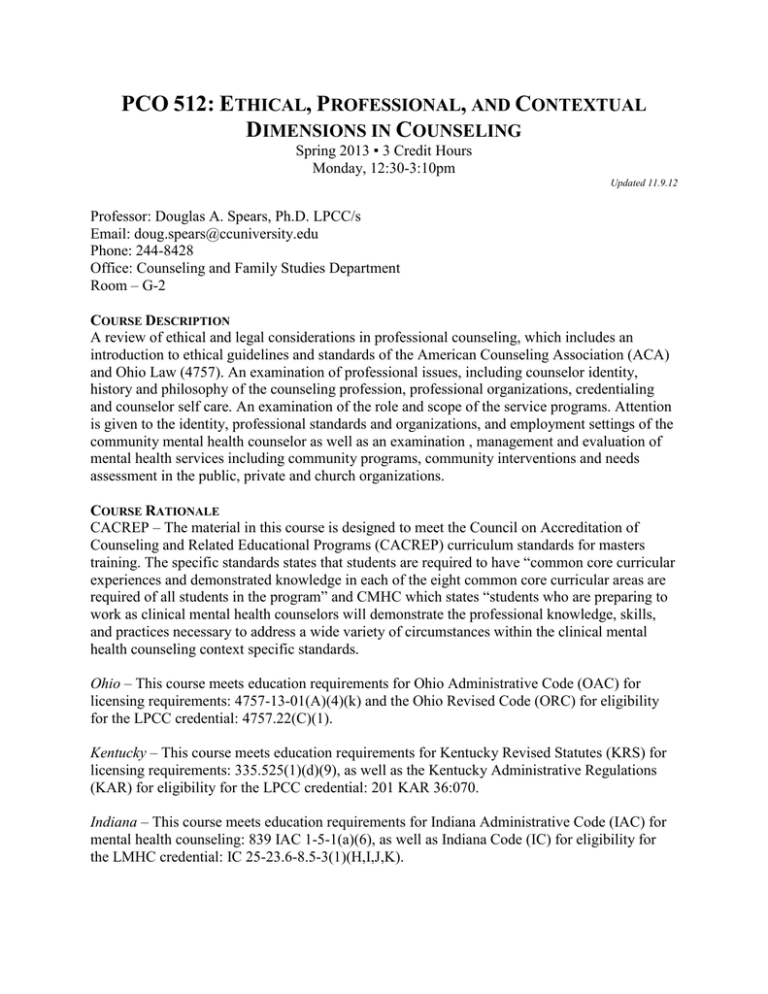
PCO 512: ETHICAL, PROFESSIONAL, AND CONTEXTUAL DIMENSIONS IN COUNSELING Spring 2013 ▪ 3 Credit Hours Monday, 12:30-3:10pm Updated 11.9.12 Professor: Douglas A. Spears, Ph.D. LPCC/s Email: doug.spears@ccuniversity.edu Phone: 244-8428 Office: Counseling and Family Studies Department Room – G-2 COURSE DESCRIPTION A review of ethical and legal considerations in professional counseling, which includes an introduction to ethical guidelines and standards of the American Counseling Association (ACA) and Ohio Law (4757). An examination of professional issues, including counselor identity, history and philosophy of the counseling profession, professional organizations, credentialing and counselor self care. An examination of the role and scope of the service programs. Attention is given to the identity, professional standards and organizations, and employment settings of the community mental health counselor as well as an examination , management and evaluation of mental health services including community programs, community interventions and needs assessment in the public, private and church organizations. COURSE RATIONALE CACREP – The material in this course is designed to meet the Council on Accreditation of Counseling and Related Educational Programs (CACREP) curriculum standards for masters training. The specific standards states that students are required to have “common core curricular experiences and demonstrated knowledge in each of the eight common core curricular areas are required of all students in the program” and CMHC which states “students who are preparing to work as clinical mental health counselors will demonstrate the professional knowledge, skills, and practices necessary to address a wide variety of circumstances within the clinical mental health counseling context specific standards. Ohio – This course meets education requirements for Ohio Administrative Code (OAC) for licensing requirements: 4757-13-01(A)(4)(k) and the Ohio Revised Code (ORC) for eligibility for the LPCC credential: 4757.22(C)(1). Kentucky – This course meets education requirements for Kentucky Revised Statutes (KRS) for licensing requirements: 335.525(1)(d)(9), as well as the Kentucky Administrative Regulations (KAR) for eligibility for the LPCC credential: 201 KAR 36:070. Indiana – This course meets education requirements for Indiana Administrative Code (IAC) for mental health counseling: 839 IAC 1-5-1(a)(6), as well as Indiana Code (IC) for eligibility for the LMHC credential: IC 25-23.6-8.5-3(1)(H,I,J,K). PCO 512 Syllabus (Spears), p. 2 COURSE OBJECTIVES 1. Identify, discuss, and demonstrate competency in critical ethical, legal, and social issues underlying counseling practice in community mental health settings: CACREP II.G.1.a, d, e, i; CMHC A.1, 5, 7; CMHC B.1; CMHC D.4; MAC 2.h. 2. Demonstrate knowledge of ACA ethical codes and guidelines and professional responsibility: CACREP II.G.1.b, f-h, j; CACREP II.G.5.f; CMHC A.2-4, 7, 8; CMHC C.1, 3, 5, 8, 9; MAC 1, 2h, 3. 3. Identify professional and legal implications (case and statutory) of professional responsibilities regulation and the implications for counselor preparation and provision of counseling services within a cultural context: CACREP II.G.1.c; CACREP II.G.5.f; CMHC A.2, 5, 7, 8; CMHC B.2, CMHC E.2, 4, 6; MAC 1, 2h, 3. METHOD OF INSTRUCTION In general, the class will follow a brief lecture, discussion, interaction, role-playing, exploration of issues, and utilizing class time for large/small group activities and exercises. Active participation is required to help develop a richer understanding of the ethical and professional issues facing counselors. Learning will be facilitated via discussion of readings/scenarios, research, writing, and examinations. Students are expected to discuss their application, insights, and understanding of the reading and the exercises with the instructor and other students. It is essential that students prepare for class by reading assigned material prior to class. REQUIRED MATERIALS Moodle and Email: All students enrolled in this course are required to check Moodle and their email weekly for the duration of the course. Course announcements, changes to the syllabus, and memos from the instructor will be distributed via Moodle and/or email. Students are responsible for all information distributed in this manner. TEXTS: Corey, G., Corey, M., & Callanan, P. (2011). Issues and ethics in the helping professions (8th ed.). Belmont, CA: Brooks/Cole. (2007). Codes of ethics for the helping professions (3rd ed.). Belmont, CA: Thomson Brooks/Cole. [packaged with Corey et al. (2011) text]Ethics Codes and Laws: American Association of Christian Counselors. (2004). AACC code of ethics. Download from http://aacc.net/about-us/code-of-ethics Ohio Counselor, Social Worker, and Marriage and Family Therapist Board. (2012). Laws and rules. Download from http://cswmft.ohio.gov/ (On Moodle) GRADING/EVALUATION Assignment Pre-chapter self-inventories (10 x 5 pts each) Chapter Quizzes (10 x 5 pts each) Group Presentation/Ethical Analysis Paper Exam 1 Exam 2 Points 50 50 100 100 100 A A- Points 475-500 460-474 Percentage 95-100% 92-94.99% B+ B 445-459 430-444 89-91.99% 86-88.99% PCO 512 Syllabus (Spears), p. 3 Exam 3 (Final) Participation Total 100 Priceless 500 BC+ C CD+ D DF 415-429 400-414 385-399 370-384 355-369 340-354 325-339 ≤ 324 83-85.99% 80-82.99% 77-79.99% 74-76.99% 71-73.99% 68-70.99% 65-67.99% < 64.99% Pre-Chapter Self-Inventories (PCSI): At the beginning of each class period, you will turn in the completed pre-chapter self-inventory for the day’s Corey et al. (2007) reading. Complete the inventory once before reading the chapter and then go back and answer the questions again after reading the chapter (record your second set of answers to the left of the answer blanks). Selfinventories may be downloaded from Moodle or you can provide your own photocopy from the book. Each self-inventory is worth 10 points for a total of 100 points (20% of your final grade). Course Objective(s): 1, 2, 3. Group Presentation/Ethical Analysis Paper: Students will work in groups to present in case format an issue and potential ethical dilemma relevant to their selected work settings (case studies will be provided by the instructor or you may utilize an example of ethical violations from the CWSMFT, ACA, or AACC websites). Groups will present recommended resolutions to the issue through the application of an ethical decision making process. Each group must identify and critically evaluate sections of the relevant professional ethical code that guide their discussion and decision-making relative to the presented issue including the disposition. Groups will work together throughout the course to review related professions’ codes of ethics (i.e., ACA, AACC), interview practicing counselors or counselor educators to determine how the issue is currently perceived and addressed, and utilize current literature, research, and class discussions to support the process. The 30 minute presentation should include: an overview of the issue, the ethical dilemma, a step-by-step discussion through an ethical decision-making process utilizing the specific ethical code(s), and a class discussion about the ethical dilemma. Each group must submit the presentation and any handouts via Moodle so they may be posted prior to the presentation date. Your paper should incorporate in-text citations and have a reference list. The paper is worth 100 points (20% of your final grade). Course Objective(s): 2 Professional writing: All written work should conform to APA style. I highly recommend that you purchase an APA publication manual for use during graduate school (and beyond). Citation: American Psychological Association. (2009). Publication manual of the American Psychological Association. Washington, DC: Author. If you choose not to buy the publication manual, you may refer to the Mini-Manual of Style, which summarizes APA style and can be downloaded from CCU’s library webpage. PCO 512 Syllabus (Spears), p. 4 Exams/Quizzes: Material for each of the three exams may be cumulative and taken from readings, discussions, and lectures. The multiple choice examination will ask students to demonstrate knowledge, understanding, application, analysis, evaluation and synthesis of concepts related to legal, professional and ethical issues in community mental health counseling. Exam items will be multiple choice. Exams are worth 100 points each for a total of 300 points. Chapter Quizzes will prior to each chapter discussed in class with the exception of the first week of the class. Quizzes are multiple choice to demonstrate knowledge and understanding of each chapter. Quizzes are worth 5 points each for a total of 50 points. Course Objective(s): 1, 2, 3. IMPORTANT NOTES Attendance and Participation: Because active discussion and experiential exercises are integral parts of the learning experiences in this course, class attendance is expected and participation in class activities and assignments is critical to your success in the course. If, for any reason, you are unable to attend class, you are still held responsible for all in-class material and any announcements made during class. Per the university’s policy (see the CCU student handbook), you have two days that are excused without penalty. If you miss three days, an additional assignment will be added. If you miss more than three classes, you will be dropped from the class and will be required to reapply for readmission to the class. A decision about your return to the class will be decided by the counseling academic committee. Because class time should be a priority, absences for lateness will be assigned as follows: 15 minutes late = ¼ day absence, 30 minutes late = ½ day absence, and over 45 minutes = 1 day absence. Graduate Coursework: Students who are planning on applying for licensure in Ohio as a Professional Counselor, the Ohio Counselor, Social Worker, and Marriage and Family Therapist Board states Rule 4757-3-01(J)(1) states: (1) “Graduate Coursework” is any coursework that meets the requirements of a post-baccalaureate degree and in which the applicant received a grade of “B-“ or higher. Late Assignments & Missed Exams/Quizzes: All assignments and exams are expected to be completed on time and due at the beginning of class on the due date. Late assignments will be accepted only at the discretion of the instructor and will incur a penalty of 10% per day. If an assignment is turned in after the start of class, it is considered late. Exams will not be given late unless there is a personal medical or family emergency. Christian Component: As we strive to provide a biblically-based approach to counseling, we expect you to evaluate all readings and discussions from a Christian perspective and work to integrate biblical truth into your life, thought, and work. Student Conduct: Except under unusual circumstances, you should not arrive late or leave early. Cell phones should be turned off. You should not IM, text-message, or surf the web during class. Grades may be lowered a full letter grade for infractions. During discussions, everyone is expected to be respectful of themselves and others. Keep in mind that it may not be appropriate PCO 512 Syllabus (Spears), p. 5 to disclose your own psychological struggles to the class. If you become distressed about any material/discussions, please talk with me and/or make an appointment to see a counselor. Accommodations: Students with special needs should speak with me or provide documentation to the office of Student Retention specifying accommodations required to help assure success. Flexibility Clause: This syllabus is NOT a binding contract. The dates of lectures, exams, projects, etc. may be revised as the term progresses. All modifications to the syllabus will be announced in class and/or via Moodle. PCO 512 Syllabus (Spears), p. 6 COURSE SCHEDULE Date Topic 1.28 Introduction to course; getting acquainted Introduction to field of counseling Professional ethics Course Objective(s): 1, 3. 2.4 Counselor as person and professional Counselor self-care Course Objective(s): 1,2,3. 2.11 Values and the helping relationship Course Objective(s): 1,2,3. 2.18 Multicultural perspective and diversity issues Course Objective(s): 1,2,3. 2.25 Exam 1 - Course Objective(s): 1,2,3. 3.4 Spring Break 3.11 Client rights and counselor responsibilities Course Objective(s): 1,2,3. 3.18 Confidentiality Multiple Relationships Course Objective(s): 1,2,3. 3.25 Competence and training Professional organizations Professional journals Course Objective(s): 1,2,3. 4.1 Exam 2 - Course Objective(s): 1,2,3. 4.8 Supervision and consultation Course Objective(s): 1,2,3,4,5,6 4.15 Learning Lab 1 4.22 Theory, practice, and research Marital and family therapy Course Objective(s): 1,2,3. 4.29 Group Course Objective(s): 1,2,3. 5.6 Community Work Course Objective(s): 1,2,3. 5.13 Final Exam - Course Objective(s): 1,2,3. Reading/Assignment Self-Assessment in Corey et al. Corey et al. Chapter 1 Corey et al. Chapter 2; PCSI Quiz – 1, 2 Corey et al. Chapter 3; PCSI Quiz – 3 Corey et. Chapter 4; PCSI Ohio Laws & Rules Quiz – 4 Corey et al. Chapter 5; PCSI ACA Code of Ethics Quiz – 5 Corey et al. Chapter 6; PCSI Corey et al. Chapter 7; PCSI Quiz – 6 & 7 Corey et al. Chapter 8; PCSI AACC Code of Ethics Quiz – 8 Corey et al. Chapter 9 Quiz – 9 Learning Lab 1 Corey et al. Chapter 10; PCSI Corey et al. Chapter 11; PCSI Quiz – 10 & 11 Corey et al. Chapter 12; PCSI Quiz – 12 Corey et al. Chapter 13; PCSI Quiz – 13 Group Report Project Rubric PCO 512 Syllabus (Spears), p. 7 Exceeds Expectations Meets Expectations Does Not Meet 3 pts 2 pts Expectations 1 pt Information is presented The report has focus The organization of the and presents ideas in a report is poor; the report General Report in a clear, concise, focused manner in the logical sequence fails to reflect graduate proper order with the level performance and/or correct headings. the report is not turned in on time. The report is of adequate The report is of The report does not Content adequate length. adequately report the test (Identified relevant length to present the professional codes) information and report There may be gaps in nor present the the codes coherently. what is presented, but relevant/necessary codes the report demonstrates and information is understanding of the lacking. information presented Information is presented Information is Information is not Writing Style in an orderly manner. presented in an orderly presented in an orderly The writer expressed manner. manner. him/herself smoothly and The writer expressed The writer did not express precisely. him/herself smoothly him/herself smoothly and The writer has avoided and precisely. precisely. redundancy, wordiness, There is little The writer has not avoided jargon, evasiveness, redundancy, wordiness, redundancy, wordiness, overuse of the passive jargon, evasiveness, jargon, evasiveness, voice, circumlocution, overuse of the passive overuse of the passive and clumsy prose. voice, circumlocution, voice, circumlocution, and There are few errors in and clumsy prose. clumsy prose. grammar, spelling, and Errors in grammar, There are many errors in punctuation. spelling, and grammar, spelling, and punctuation are present, punctuation. but do not significant. Report is written in an There are minimal The report is not APA Style appropriately errors in APA style, but consistent with APA style. professional style. they do not detract from All elements of the report the overall quality of are consistent with APA the report. guidelines. PCO 512 Syllabus (Spears), p. 8 Use of Language: Constructions that might Constructions are free Constructions include from bias with one or some significant bias. Cultural Awareness imply bias against persons have been two minor exceptions. Readers may be offended. avoided. Differences are mentioned only when relevant. Writing reflects respect for others and the reader. PCO 512 Syllabus (Spears), p. 9 Oral Presentation Rubric Oral Communication: Expressing ideas clearly when communicating orally. Exceeds Expectations Meets Expectations Does Not Meet Criteria 3 pts. 2 pts. Expectations 1 pt. Listener can follow presentation with effort. Presentation is Presentation is clear, logical Some arguments are generally clear and and organized. not clear. well- organized. Organization Listener can follow line of Organization seems A few minor points reasoning. haphazard. may be confusing Listeners may be confused Level of presentation is Aspects of presentation Level of presentation is generally appropriate. are too elementary or appropriate for the audience. Pacing is sometimes too sophisticated for Presentation is a planned too fast or slow. audience. conversation, paced for The presenter seems Presenter seems audience understanding. Style slightly uncomfortable uncomfortable and can It is NOT a reading of a paper. at times, and the be heard only if listener Speaker is clearly comfortable audience occasionally is very attentive. in front of the group and can be has trouble hearing the Much of the heard by all. him/her. information is read. Communication aids Communication aids enhance Communication aids are poorly prepared or Use of the presentation. contribute to the quality used inappropriately or Communication They are prepared in a of the presentation. are absent. Aids professional manner. Font size is appropriate Font is too small to be (e.g., Font on visuals is large enough for reading. easily seen. Transparencies, to be seen by all. Appropriate Too much information Slides, Posters, Information is organized to information is included. is included. Handouts, maximize audience Some material is not Unimportant material is Computerunderstanding. supported by visual highlighted. Generated Detail is minimized so that aids. Listeners may be Materials) main points stand out. confused Speaker provides an accurate For the most part, Explanations of and complete explanation of explanations of concepts and/or key concepts and theories, concepts and theories theories are inaccurate are accurate and or incomplete. Content: Depth drawing upon relevant complete. Little attempt is made of Content literature. Applications of theory are Some helpful to tie theory to practice. included to illuminate issues. applications are Listeners gain little Listeners gain insights. included. from the presentation. PCO 512 Syllabus (Spears), p. 10 Criteria Content: Accuracy of Content Use of Language: Grammar and Word Choice Use of Language: Cultural Awareness Personal Appearance Does Not Meet Expectations Enough errors are made to distract a knowledgeable listener, but some information is accurate. The presentation is No significant errors useful if the listener can are made. Information (names, facts, etc.) determine what Listeners recognize any included in the presentation is information is reliable. errors to be the result of consistently accurate. Information included is nervousness or sufficiently inaccurate oversight. that the listener cannot depend on the presentation as a source of accurate information. Listeners may have been misled. Listeners can follow the For the most part, presentation, but some sentences are complete Sentences are complete and grammatical errors and and grammatically grammatically correct, and use of slang are evident. correct, and they flow they flow together easily. Some sentences are together easily. Words are chosen for their incomplete, halting, With a few exceptions, precise meaning. and/or vocabulary is words are chosen for somewhat limited or their precise meaning. inappropriate. Oral language and/or Oral language and body body language includes Both oral language and body language are free from some significant bias. language are free from bias. bias with one or two Listeners may be minor exceptions. offended. For the most part, Personal appearance is Personal appearance is personal appearance is somewhat inappropriate completely appropriate for the appropriate for the for the occasion and occasion and the audience. occasion and the audience. audience. Exceeds Expectations Meets Expectations
